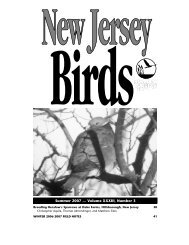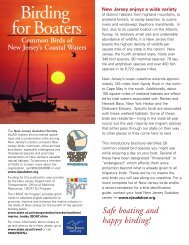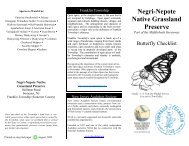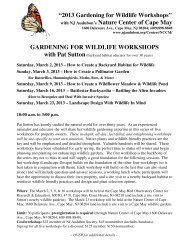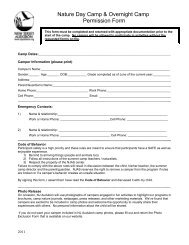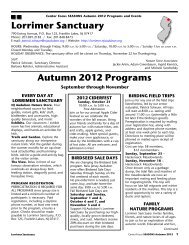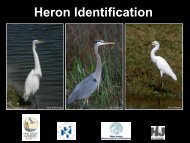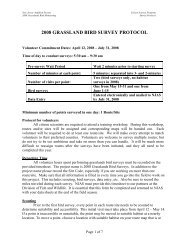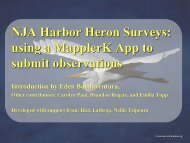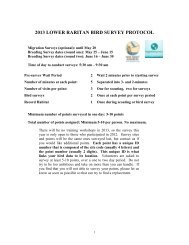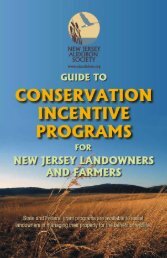Forest Management and Indiana Bats - New Jersey Audubon Society
Forest Management and Indiana Bats - New Jersey Audubon Society
Forest Management and Indiana Bats - New Jersey Audubon Society
You also want an ePaper? Increase the reach of your titles
YUMPU automatically turns print PDFs into web optimized ePapers that Google loves.
United StatesDepartment of AgricultureNatural ResourcesConservation Service<strong>New</strong> <strong>Jersey</strong> Fact Sheet: <strong>Forest</strong> <strong>Management</strong> <strong>and</strong> <strong>Indiana</strong> <strong>Bats</strong>IntroductionThe <strong>Indiana</strong> bat (Myotis sodalis) is a small insectivorousmammal that inhabits the eastern half of the UnitedStates. In <strong>New</strong> <strong>Jersey</strong>, this bat species is known to occurin the Northern <strong>and</strong> Central Highl<strong>and</strong>s regions, withpotentially suitable habitat existing throughout thenorthern part of the state. As a nocturnal insectivore, the<strong>Indiana</strong> bat consumes large quantities of flying insects,including mosquitoes <strong>and</strong> agricultural pests. In 1967,sharp declines put this mammal on the federalendangered species list, <strong>and</strong> in 1973 it became the state’sonly endangered bat species.From April through September, <strong>Indiana</strong> bats typicallyinhabit both upl<strong>and</strong> <strong>and</strong> wetl<strong>and</strong> forests. Female <strong>Indiana</strong>bats form maternity colonies with as many as 100individuals that gather <strong>and</strong> raise their young together.Males spend the summer alone or in small groups, oftenliving near the maternity colonies. In the fall, theseanimals will begin their migration back to theiroverwintering sites, which are typically within a 30-mileradius of their summer territory, but can be more than100 miles away. During this time they mate <strong>and</strong> foragein preparation for hibernation. From late October toApril, <strong>Indiana</strong> bats hibernate with other bat species incaves <strong>and</strong> old mines. This species is a crucial componentin <strong>New</strong> <strong>Jersey</strong>’s ecosystems <strong>and</strong> provides significantbenefits to agriculture <strong>and</strong> public health.Threats <strong>and</strong> DeclineThe <strong>Indiana</strong> bat, one of nine bat species in <strong>New</strong> <strong>Jersey</strong>,faces several threats, including human disturbance,habitat destruction, <strong>and</strong> disease, as well as having a slowreproductive rate <strong>and</strong> specialized habitat requirements. Arecent threat is the onset of White-Nose Syndrome(WNS), a fungus that disrupts the bats’ regularhibernation cycle, often killing them. Prior to the currentpopulation decline that started in the late 1960s, nearly85 percent of all <strong>Indiana</strong> bats in <strong>New</strong> <strong>Jersey</strong> hibernatedin only seven caves. This limited distribution, combinedwith reduced numbers of bats, makes this speciesvulnerable to disturbance. This species requires specificconditions for hibernation, <strong>and</strong> even small changes intemperature, moisture, <strong>and</strong> air flow at overwinteringPicture of <strong>Indiana</strong> Bat<strong>Indiana</strong> bat (Myotis sodalis) (© Adam Mann, EnvironmentalSolutions <strong>and</strong> Innovations, USFWS)sites can be damaging. Successful rearing of young alsodepends on the conditions surrounding the maternitycolony. Females have a low reproductive rate, givingbirth to only one or two offspring per year. Such lowfecundity means that even minimal mortality to youngcan result in severe impacts to the population.Habitat RequirementsThe United States Fish <strong>and</strong> Wildlife Service (USFWS)has determined minimum suitable habitat characteristicsfor the summer range of this endangered bat species.Typically, forested wetl<strong>and</strong>s <strong>and</strong> forested upl<strong>and</strong>sprovide the best resources for the <strong>Indiana</strong> bat. For everyacre of forest, at least 16 “roost trees” should be present.These roost trees can be described as:• Live shagbark hickory (Carya ovata) trees• Lightning-struck trees, 9 inches in diameteror more• Dead or dying trees with some exfoliating(flaking) bark remaining• Any tree greater than 26 inches in diameterRoost trees provide individual bats with cover frompredators <strong>and</strong> harsh weather conditions while alsoproviding a microclimate of optimal temperatures. Ingeneral, summer roosts will fall into two categories, theprimary roosting sites <strong>and</strong> the alternate roosting sites.1
Primary roosting sites are typically in open, sunnypatches adjacent to water, <strong>and</strong> are occupied repeatedlythroughout the summer. Alternate roosting sites areinhabited far less frequently, but are sometimes foundwithin a forest interior. These sites are generally usedwhen the primary roosts are unavailable or whenconditions there are unfavorable, for example whenpredators or parasites are present. Optimum foragingconditions are often closely related to sources of water,so riparian <strong>and</strong> wetl<strong>and</strong> habitats are highly valuable. Insome instances, early successional meadows may also begood sources of food.<strong>Management</strong> PlanningThis mammal is known to occur in Sussex, Passaic,Morris, Union, Essex, Somerset, <strong>and</strong> Hunterdoncounties, with potential habitat in Warren, Bergen,Middlesex, <strong>and</strong> Mercer counties. In these counties it iscritical to consider the <strong>Indiana</strong> bat’s habitat requirementswhile managing forests. Before any management plansare implemented, it is important to determine if thisspecies occupies the project site. The <strong>New</strong> <strong>Jersey</strong>Endangered <strong>and</strong> Non-game Species Program (ENSP)maintains a mapping tool called the L<strong>and</strong>scape Projectthat provides information to l<strong>and</strong>owners regarding rare<strong>and</strong> endangered wildlife occurrences. Informationregarding this tool can be found on ENSP’s website. Alist of municipalities that have <strong>Indiana</strong> bat records is alsomaintained by the USFWS <strong>and</strong> can be found on theUSFWS <strong>New</strong> <strong>Jersey</strong> Field Office website. Thisinformation should be incorporated into a <strong>Forest</strong>Stewardship Plan that will then outline certainprecautions to avoid adverse effects to <strong>Indiana</strong> batswhile also improving the habitat.With proper planning, a <strong>Forest</strong> Stewardship Plan can notonly meet a l<strong>and</strong>owner’s goals <strong>and</strong> objectives, but alsoavoid harm to an existing bat population whileimproving or maintaining suitable habitat. Improvedhabitat for <strong>Indiana</strong> bats will also benefit many other batspecies <strong>and</strong> wildlife that occur in <strong>New</strong> <strong>Jersey</strong> as well asenhance economic <strong>and</strong> ecological value to a forest st<strong>and</strong>.<strong>Indiana</strong> bats inhabit forested upl<strong>and</strong>s <strong>and</strong> wetl<strong>and</strong>s that provide cover,food, <strong>and</strong> water (John Parke, NJA)Managing <strong>and</strong> Improving Potential HabitatSeveral options are available to provide suitable habitatfor <strong>Indiana</strong> bats. Due to the sensitivity of this species,l<strong>and</strong>owners managing or creating habitat for this speciesshould consult a natural resource professional as well asthe appropriate state <strong>and</strong> federal agencies beforeimplementing management activities. A <strong>Forest</strong>Stewardship Plan that focuses on wildlife habitatmanagement will often present the best options,including:• Maintain 60% canopy closure (USFWS)• Preserve snags (st<strong>and</strong>ing dead trees) <strong>and</strong>dead or dying trees (USFWS)• Preserve shagbark hickories (C. ovata) <strong>and</strong>other valuable roost trees (USFWS)• Selectively remove trees near valuable roosttrees to provide more solar exposure• Girdle select trees to create more st<strong>and</strong>ingsnags• Create small forest openings to serve asforaging areas• Create artificial roosts using shingles,asphalt paper, bat boxes, etc(Left to right) Shagbark hickories (C. ovata) naturally have exfoliating bark that provides <strong>Indiana</strong> bats with vital roosting sites (John Parke, NJA);however, roost trees can be created by girdling select trees (Don Donnelly, NJA) or by preserving st<strong>and</strong>ing snags (Kristen Meistrell, NJA). Artificialroosts can also be created using various materials (shingles, asphalt paper, etc.) that mimic structural elements of a roost tree (John Parke, NJA)2
<strong>Indiana</strong> bats spend the winter hibernating in caves <strong>and</strong> ab<strong>and</strong>oned mines, like this one in Morris County (left, © Christopher Magarelli). This mammaloften hibernates in large groups (middle, © John R. Omer, USFS) along with other bat species, including the little brown bat (Myotis lucifugus) (right,Kristen Meistrell, NJA)• Create artificial water sources (small ponds,vernal pools) for drinking water <strong>and</strong>increased foraging opportunitiesGirdling, selective removal of competitive vegetation,herbicide application, <strong>and</strong> prescribed burns can also beintegrated in order to promote tree vigor <strong>and</strong> foresthealth. Certain restrictions <strong>and</strong> regulations may apply towetl<strong>and</strong> or riparian (stream or river) areas, so it isimportant to consult an approved forester or naturalresource professional.Preventing Disturbance in Known LocationsThe USFWS maintains a list of Best <strong>Management</strong>Practices to guide forestry operations in known orpotential <strong>Indiana</strong> bat habitat. Each site <strong>and</strong> project mayrequire additional precautions, so it is important toconsult ENSP <strong>and</strong> USFWS for proper guidance;however, some recommendations include:• Implement operations during the hibernationperiod (typically November 15 throughMarch 31)• Limit forestry operations within 300 feet ofa water source• Limit forestry operations within 500 feet ofa known hibernaculum• Avoid the use of prescribed burns within1,000 feet of a known hibernaculum• Minimize forest fragmentation <strong>and</strong> preservelarge, contiguous tracts of habitatFinancial <strong>and</strong> Technical AssistanceA <strong>Forest</strong> Stewardship Plan that incorporates some of themanagement practices discussed above can promote ahealthy ecosystem that is beneficial to <strong>Indiana</strong> bats <strong>and</strong>other wildlife. An approved forester or natural resourceprofessional can assist with the development <strong>and</strong>implementation of the plan, however; the l<strong>and</strong>owner isgenerally responsible for all costs <strong>and</strong> applicable fees.The Natural Resources Conservation Service (NRCS)offers technical <strong>and</strong> financial assistance to forestl<strong>and</strong>owners through the Environmental QualityIncentives Program (EQIP). Eligible l<strong>and</strong>owners with 10acres or more of forest l<strong>and</strong> may receive cost-shareassistance for the development <strong>and</strong> implementation of a<strong>Forest</strong> Stewardship Plan. <strong>Forest</strong> Stewardship Plans costsharedthrough EQIP must be prepared by an NRCSapproved Technical Service Provider (TSP). A list ofTSPs can be found at a local NRCS service center or onthe NJ NRCS website.NRCS office locations <strong>and</strong> more detailed informationabout NRCS assistance <strong>and</strong> the EQIP program canbe found at: www.nj.nrcs.usda.gov/Bat populations throughout the United States have been in decline due to habitat destruction <strong>and</strong> the onset of White Nose Syndrome (little brown batpictured, left, <strong>New</strong> York Dept. Environmental Conservation). Biologists have been diligently researching <strong>and</strong> monitoring these populations (middle, ©Bryon Dubois) while several preventative measures have been taken to minimize disturbance to bats, including gate installations at known hibernacula(right,© Joe Milmoe, USFWS)3
For More Information:General Information on NRCS <strong>Forest</strong>ry Programswww.nj.nrcs.usda.gov/technical/forestry/index.htmlInformation on NRCS EQIP Programwww.nj.nrcs.usda.gov/programs/eqip/forestry.htmlLocating an NRCS TSPhttp://techreg.usda.gov/CustLocateTSP.aspxList of NJDEP-Approved Consulting <strong>Forest</strong>erswww.state.nj.us/dep/parks<strong>and</strong>forests/forest/ACF.pdfNJDEP, Division of Fish <strong>and</strong> Wildlife-<strong>Indiana</strong> <strong>Bats</strong>http://www.nj.gov/dep/fgw/ensp/pdf/endthrtened/indianabat.pdfUSFWS Information <strong>and</strong> <strong>Management</strong> for <strong>Indiana</strong> <strong>Bats</strong>http://www.fws.gov/northeast/njfieldoffice/Endangered/Ibat.htmlUSFWS <strong>New</strong> <strong>Jersey</strong> Field Office Procedure for Consultationhttp://www.fws.gov/northeast/njfieldoffice/Endangered/consultation.htmlConserve Wildlife Foundation of NJ-<strong>Indiana</strong> <strong>Bats</strong>http://www.conservewildlifenj.org/species/fieldguide/view/Myotis%20sodalis/US <strong>Forest</strong> Service-<strong>Indiana</strong> <strong>Bats</strong>http://www.fs.fed.us/database/feis/animals/mammal/myso/all.html#WILDLIFE DISTRIBUTION AND OCCURRENCEBat Conservation International, <strong>Forest</strong> <strong>Management</strong> <strong>and</strong><strong>Bats</strong> http://www.batcon.org/pdfs/<strong>Forest</strong>Mgmt<strong>and</strong><strong>Bats</strong>.pdfFederal <strong>and</strong> State Agency Contact Information:<strong>New</strong> <strong>Jersey</strong> ENSPDivision of Fish <strong>and</strong> WildlifeDepartment of Environmental ProtectionP.O. Box 400Trenton, NJ 08625(609) 292-9400http://www.state.nj.us/dep/fgw/ensphome.htmUS Fish <strong>and</strong> Wildlife Service<strong>New</strong> <strong>Jersey</strong> Field Office927 North Main Street, Building DPleasantville, NJ 08232(609) 646-9310http://www.fws.gov/northeast/njfieldoffice/The U.S. Department of Agriculture (USDA) prohibits discrimination in all of itsprograms <strong>and</strong> activities on the basis of race, color, national origin, age, disability,<strong>and</strong> where applicable, sex (including gender identity <strong>and</strong> expression), maritalstatus, familial status, parental status, religion, sexual orientation, political beliefs,genetic information, reprisal, or because all or part of an individual's income isderived from any public assistance program. (Not all prohibited bases apply to allprograms.) Persons with disabilities who require alternative means forcommunication of program information (Braille, large print, audiotape, etc.)should contact USDA's TARGET Center at (202) 720-2600 (voice <strong>and</strong> TDD).4



